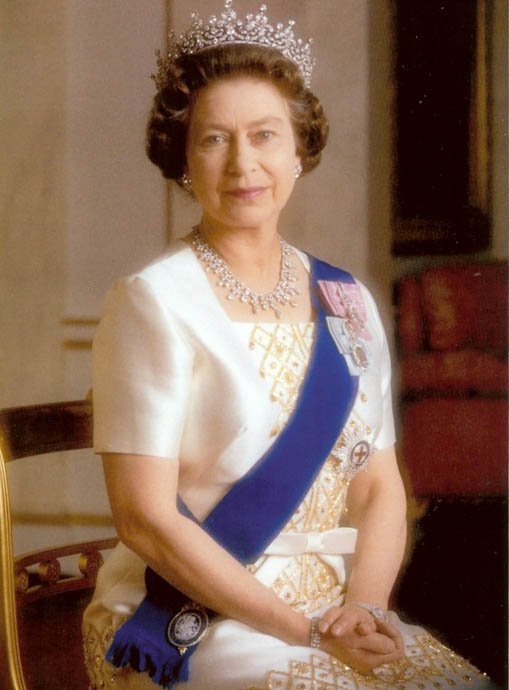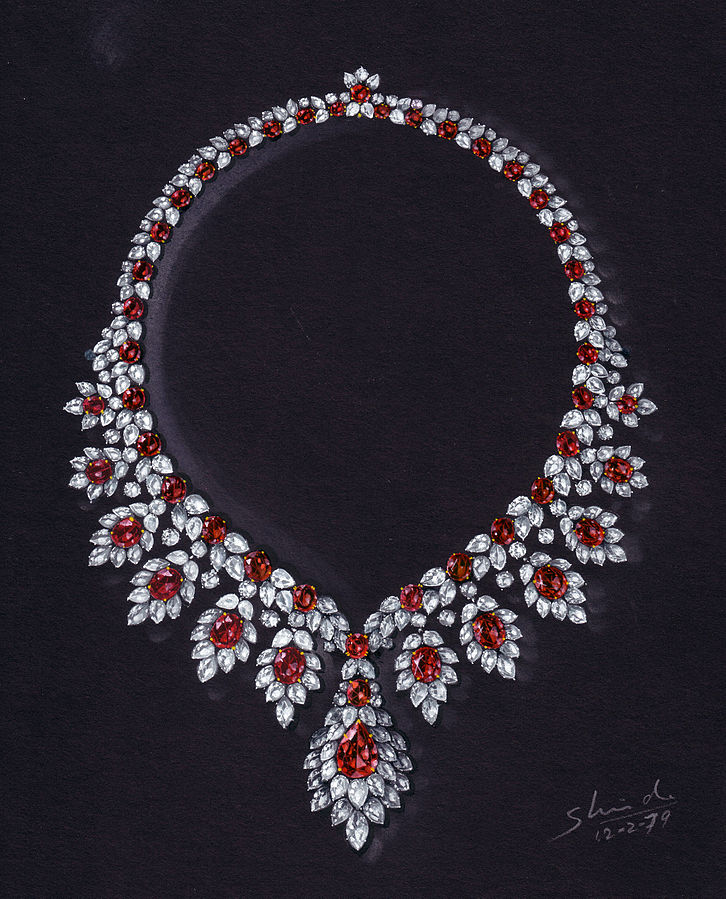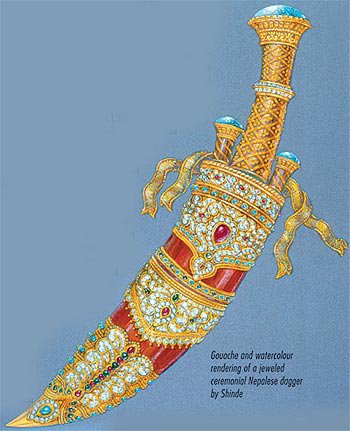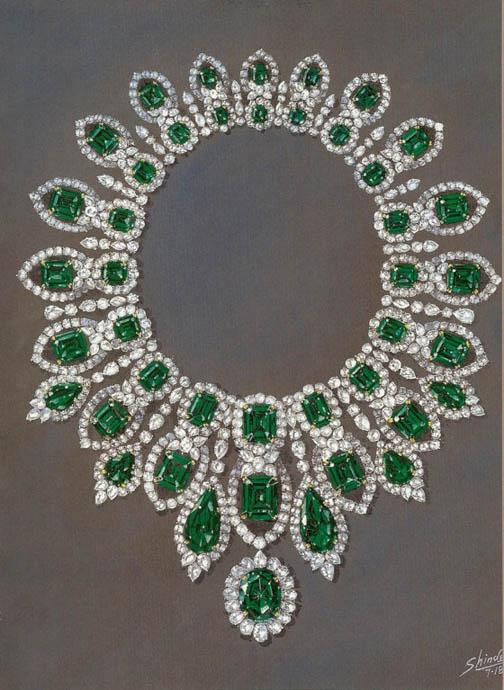Designing jewellery pieces was never a part of Ambaji Shinde’s plans. But his father’s untimely death forced him to take up a job at a local jewellery store in order to support his younger siblings. What started as a need to fulfill his responsibility as the eldest son soon turned him into a renowned jewellery designer, sought after across the world.
Shinde’s impeccable calibre, design sense and distinctive fashion statement translated into bespoke pieces of jewellery. His creations made their way into the world of trousseau and heirloom pieces adorned by royalty and celebrities alike, in a career that spanned four decades.
Some of these names include Queen Elizabeth II, Elizabeth Taylor, Sophia Loren, Oprah Winfrey, Madonna, Maharaja of Baroda, the Nizam of Hyderabad, King Farouk of Egypt, Sheikh Ibn Saud of Saudi Arabia, and many more.

Gemologist and philanthropist Harry Winston from New York, known as the ‘King of Diamonds’, recognised Shinde’s potential and gave him a job at his firm in 1962. Winston called Shinde ‘Jewel behind the Jewel’ and rightly so, given that more than 5,000 of his sketches are being used to teach designing students at the Gemological Institute of America.
The Winston Estate has preserved over 1,00,000 design drawings made by Shinde, which remain a prominent source of inspiration even today. “These archives not only create an important link to preserve our heritage, but often provide that creative spark that we use to ignite new interpretations of Harry Winston jewels for the next generations. For example, we have recently launched a brand new collection, called Ultimate Adornments by Harry Winston. The 40-piece collection will explore different costumes and adornments from around the world, and has been directly inspired by the archival drawings of Shinde and his incredible sketches of Caftan inspired necklaces,” Frederic De Narp, CEO of Harry Winston, told Mint in a 2011 interview.

Shinde was born in Mapusa, a small town clustered around Mount (Alto) in Goa in 1918. We trace his glittering legacy, his remarkable innovations and how he used his traditional knowledge to embellish the world of precious stones.
Accidental art

Shinde’s father, Venkatesh, was a bangle-maker, and so Shinde was naturally drawn to art from a very young age. However, due to a modest lifestyle, he couldn’t afford paper and colours. According to Live History India, he would hunt for discarded carbon papers at a local police station to trace designs.
It was one of his teachers who recognised his talent and advised his parents that they send him to J J School of Arts in Mumbai to study Textile Design in the 1930s. Here, Shinde stayed with a family friend in a tiny chawl. By the time he completed his diploma, his father had passed away, which forced him to look for a job.
He received an opportunity to work with Narauttam Bhau Jhaveri, a known name in the jewellery industry. While Shinde had no experience, he was hired because of his impressive sketches. Shinde found a mentor in Nanubhai, who taught him everything, from carving to designing and arranging gems. Nanubhai played a huge role in moulding Shinde’s jewellery making prowess.
Shinde bagged his first royalty project for Maharaja Sayajirao Gaekwad of Baroda in 1938. He began receiving similar projects over the next two years.

In 1940, Shinde got married and quit his first job to work for his mentor, who had by then started his own firm, Nanubhai Jewelers. Shinde spent the next two decades honing his craft, experimenting with innovative designs and making his mark in the world of the rich and famous.
Shinde drew inspiration from mundane life and gave it a glamorous spin. He designed turban pins, pear ropes and coronation jewels for kings including Maharajas of Porbandar and Dhar, as well as the Nizam of Hyderabad. He incorporated religious symbols and Indian ethnic motifs in the jewellery sets for the royal families.
According to some reports, Shinde brought about a transformation to the notion of owning a piece of jewellery. Historically, jewels were a statement of power, prosperity and prestige for the rulers. In other words, weight, size and number of jewels were in direct proportion to one’s status.

However, when the Maharajas went on international visits, they preferred western-influenced jewellery, which was light and small. So Shinde reduced the weight and added more elegance.
One highly noted creation of Shinde’s came about in 1946, a year before India’s fascination with jewels would change forever. He incorporated more than 1,200 diamonds in a stunning white Sari worn by the third wife of Aga Khan III on the 60th anniversary of his reign.
Recognition, respect & a modest lifestyle
An end of colonial rule led to the Partition of India and the discontinuation of aristocracy. Maharajas stopped ordering luxurious sets and instead dismantled existing ones to hide or sell expensive gems and diamonds.
Nanubhai took advantage of this and purchased the gems and stones from these Maharajas. From these, Shinde created masterpieces in the form of necklaces, rings, earrings and bracelets.

While he enjoyed his work, Shinde foresaw the dull future in the business and decided to explore the international segment of jewellery. In 1959, he received a job opportunity from Winston in New York. Winston had worked with Nanubhai in the past and was already impressed with Shinde’s work.
Shinde worked at Winston’s Geneva office as he waited for a visa and moved in 1962. He left behind an ailing wife and six children. In 1964, he moved to India for some time and then went back to New York in 1966. He would go on to stay in a one-bedroom apartment for the next 30 odd years.
Winston’s western designs and Shinde’s traditional roots led to an outburst of ornamentation, elegance and lush extravagance. His intricate stonework, aesthetic sense and attractive patterns for stones such as emerald soon caught the attention of jewellery connoisseurs across the world.

In the Mint interview, De Narp spoke of “Shinde’s ability to examine the world around him, derive new inspirations and translate this into exceptionally beautiful jewellery designs. In particular…he was able to blend the ornate, romantic style of his native India, with the elegant simplicity of classic Harry Winston designs.”
One of Shinde’s early works included designing a 69.42-carat diamond necklace shaped like a pear in 1966. Three years later, it was purchased by actor Richard Burton for Elizabeth Taylor.

Another valuable piece was the Centennial Tiara for the Harry Winston brand on clocking a century. The tiara was infused with seven rare diamonds weighing 100 carats. It was valued at $43 million in 1990. The Wreath Necklace, comprising 150.24 carats of diamonds was worn by Gwyneth Paltrow at the Oscars in 1999. It was said that her father bought the choker from Harry Winston at $175,000 after she won the award.
Till his retirement in 2001, Shinde created several gorgeous pieces glittering with fine gemstones, each having its unique style and pattern. Two years later, he died in 2003 in New York, at the age of 85.
While he gained a massive amount of fame, respect and recognition through his career, he never let it get to his head. It was believed that he continued with a modest lifestyle, did his own chores and rode the bus to the Winston studio every day.
The Winston Estate perfectly sums up Shinde’s great talent and how there has been no one like him since. “While a customer may have had trouble visualising how a finished piece would look, Shinde had no such difficulty. With several strokes on the paper, [he] could draw a jewel and make it sparkle off the page.”
Featured image source
Edited by Divya Sehtu
No comments:
Post a Comment